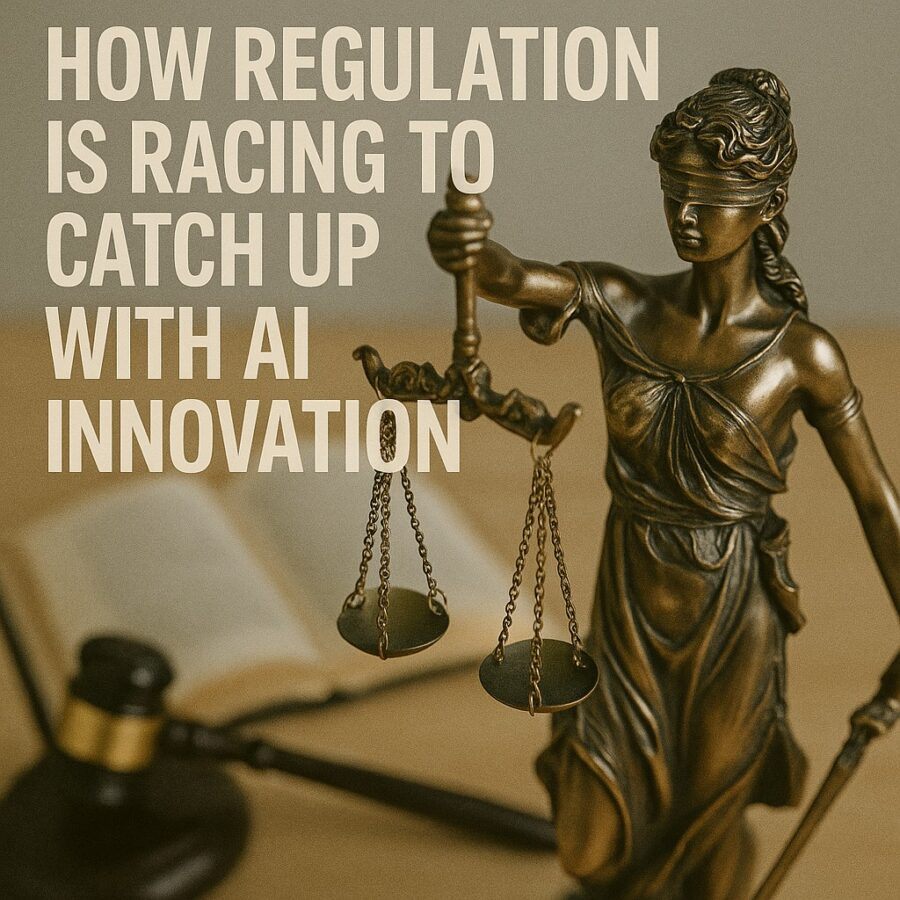Views: 4
Artificial intelligence is advancing faster than any prior technology in modern history. From generative models creating essays and images to autonomous agents handling business workflows, AI is reshaping society in real time. Yet laws, standards, and accountability measures are struggling to keep pace. Around the world, policymakers recognize that regulation is racing to catch up with AI innovation, but the effort is uneven, complex, and filled with tension between progress and protection.
This article explores the dynamics of that race. It examines the urgency, the regional differences, the risks of lagging behind, and the future of governance in an AI-driven world.
Why AI Innovation Outpaces Regulation
The speed of artificial intelligence development is astonishing. Each year brings new models with more parameters, more capabilities, and wider adoption. By contrast, regulatory processes are deliberate, often requiring years of debate, negotiation, and implementation.
This gap explains why regulation is racing to catch up with AI innovation. Legislators craft rules based on what already exists, while technology companies introduce tools that reshape the conversation before laws are even enacted. The result is a perpetual lag, where legal frameworks address yesterday’s issues while today’s systems move forward unchecked.
Early Lessons from Technology History
This challenge is not unique to AI. The internet, social media, and cryptocurrencies all advanced before strong regulatory frameworks were established. In each case, society dealt with consequences of insufficient oversight: misinformation, privacy violations, financial fraud, and monopolistic practices.
The lesson is clear. Failing to act quickly risks widespread harm. This is why governments now insist that regulation is racing to catch up with AI innovation before similar crises unfold. The stakes are higher because AI does not just spread information or currency. It influences human decision-making, creativity, employment, and even national security.
The European Union’s Bold Step
Among global players, the European Union has moved fastest. Its AI Act is the first comprehensive framework designed to govern artificial intelligence. It categorizes systems into levels of risk, from minimal to unacceptable, and assigns obligations accordingly.
- High-risk applications in healthcare, finance, and critical infrastructure face strict transparency and safety requirements.
- Banned practices include social scoring and manipulative systems targeting vulnerable populations.
- General-purpose models are required to disclose training data and risks.
The EU demonstrates how regulation is racing to catch up with AI innovation by setting rules proactively rather than waiting for disasters. Yet critics warn that heavy compliance may slow startups compared to rivals in less regulated regions.
The United States: A Fragmented Approach
The United States, home to most leading AI companies, has adopted a more fragmented strategy. Federal agencies issue guidelines for specific sectors, while states experiment with their own rules. The White House issued an executive order outlining principles for AI safety, fairness, and accountability.
However, there is no single federal law equivalent to the EU’s AI Act. This patchwork approach reflects both political gridlock and a cultural preference for innovation-first ecosystems. As a result, regulation is racing to catch up with AI innovation in the U.S., but at a slower pace. The lack of clear standards creates uncertainty for businesses and raises questions about consumer protection.
China’s State-Directed Strategy
China views AI as a pillar of national power. The government has imposed rules requiring platforms to watermark synthetic content and monitor AI-generated information for alignment with state values. Unlike the EU and U.S., China’s approach is centralized and tied to political goals as much as consumer protection.
This model shows another way regulation is racing to catch up with AI innovation. Instead of gradual consensus, China enforces rapid, top-down measures. While effective in setting clear boundaries, the approach raises concerns about censorship and limited transparency.
The Role of International Cooperation
AI is global by nature. Models are trained on data from around the world, and applications cross borders instantly. No single country can fully regulate the technology in isolation. This reality highlights why regulation is racing to catch up with AI innovation at an international level.
Organizations such as the G7 and the OECD are working on shared principles for AI governance. Proposals include global standards for transparency, auditing, and ethical development. However, achieving consensus across nations with different political and economic systems remains challenging.

MSI Gaming GeForce RTX 3060 12GB 15 Gbps GDRR6 192-Bit HDMI/DP PCIe 4 Torx Twin Fan Ampere OC Graphics Card
Risks of Regulatory Delay
The cost of slow or ineffective governance is significant.
- Bias and discrimination: AI trained on flawed datasets can perpetuate inequality.
- Privacy violations: Systems may collect and misuse sensitive information.
- Market concentration: A few companies may dominate global AI resources, stifling competition.
- Security threats: Autonomous tools could be exploited for cyberattacks or disinformation.
These risks emphasize why regulation is racing to catch up with AI innovation. Without timely frameworks, harms could become entrenched before safeguards are established.
Balancing Innovation and Oversight
A central tension in AI governance is balance. Heavy regulation may stifle progress, while weak oversight allows abuses. Policymakers must navigate between encouraging innovation and preventing harm.
For example, startups argue that excessive compliance could crush creativity. Yet consumer advocates warn that leaving innovation unchecked risks repeating the social media crisis, where platforms profited while society paid the price.
The delicate act of balance explains why regulation is racing to catch up with AI innovation in a cautious, iterative fashion rather than through sweeping bans or laissez-faire neglect.
Sector-Specific Challenges
Different industries present unique challenges.
- Healthcare: AI diagnostic tools promise accuracy but raise questions about liability when mistakes occur.
- Finance: Algorithmic trading and credit scoring require transparency to avoid systemic risks and bias.
- Education: AI tutors can personalize learning but may also collect sensitive student data.
- Defense: Autonomous weapons present ethical dilemmas with global security implications.
These examples show that regulation is racing to catch up with AI innovation not only at a general level but also within each domain where AI is deployed.
Corporate Responsibility
Companies developing AI cannot wait for governments alone. Many have adopted voluntary safeguards, such as publishing model cards that detail risks, setting up ethics boards, and introducing usage restrictions.
Yet voluntary action has limits. Critics argue that self-regulation often prioritizes public relations over real accountability. Still, industry initiatives highlight recognition that regulation is racing to catch up with AI innovation, and businesses must prepare for stricter rules.
Public Awareness and Civil Society
Civil society groups, academics, and activists also play a role. They pressure governments and corporations to consider human rights, fairness, and transparency. Public debate over deepfakes, misinformation, and job displacement keeps pressure on policymakers.
The role of public opinion ensures that regulation is racing to catch up with AI innovation is not only a legislative struggle but a cultural one. Awareness shapes the urgency and direction of reform.
Looking Ahead: The Future of AI Governance
Where does the race lead? Several trends are emerging:
- Auditing requirements: Expect mandatory audits of large AI systems for safety and bias.
- Transparency standards: Laws will likely require disclosure of training data sources and model limitations.
- Global benchmarks: International coalitions may agree on shared minimum standards to prevent regulatory arbitrage.
- Adaptive laws: Flexible frameworks could evolve with technology, ensuring rules remain relevant.
These directions suggest that while regulation is racing to catch up with AI innovation, it is gradually finding its footing.
Closing Thoughts
Artificial intelligence is advancing at breathtaking speed. Laws, norms, and institutions struggle to adapt, yet they must. Without effective governance, AI risks amplifying inequality, destabilizing markets, and eroding trust.
The phrase regulation is racing to catch up with AI innovation captures both urgency and inevitability. This is not a race that can be avoided. It is one that must be run carefully, balancing creativity with accountability.
The future will depend on whether governments, corporations, and civil society can build frameworks as dynamic as the technology itself. Only then will AI evolve as a force that empowers rather than destabilizes.




